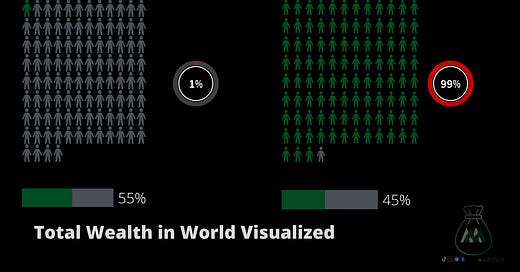The Wealth Gap in America: What You Need to Know
In the United States, the wealth gap is a huge problem that has been going on for decades. The gap between rich and poor is widening, and it's not just in America. It's happening all over the world.
Good morning everyone,
Today, I have a hot topic: the ever-growing wealth gap not only in America but all over the world. The Wealth Gap is an issue that affects every American, and it has a direct impact on the way we live; it’s not just something that can be ignored.
First, let’s talk about what the wealth gap is.
The wealth gap is a term that refers to the economic inequality between different classes of people.
For Example:
The top 1% of the population has more than half of the world’s wealth, while the bottom 50% has less than 1%.
There are many ways to define and explain this phenomenon, but one of the most common metaphors is that of a ladder. The ladder represents social class, with each step representing a different level of economic status. Those who are at the bottom rung have less opportunity and less wealth than those at higher levels.
The gap can be due to inheritance, luck, or any other number of factors. However, the wealth gap in America has grown substantially over the past few decades, and it is now wider than ever before.
How the Wealth Gap Affects America
In the early 20th century, America was an increasingly equal nation. When wealth was unevenly concentrated, there were at least things that everyone could do to make money (if not be wealthy), such as founding a company and investing in land. Today’s job market requires specific skills and formalized education - things not all Americans have. Working born with higher wealth means that people can afford expensive, sophisticated educations and connections built through movies and sports accomplishments when others’ only assets are their skills at Walmart. These facts are never more apparent than when looking at Forbes’s annual billionaire’s list- often providing stark evidence that inequality is a real and growing problem in America. According to The New York Times, the U.S. had more than 2,000 billionaires in 2017, up from 1,810 in 2016. In 2007 there were about 600 billionaires; that number has more than tripled as of today’s statistics.

The wealth gap in America can also be seen by looking at the difference between the median income of whites and blacks. In 2009, white households had a median income of $71,900, while black families had a median income of $32,300. This difference in income shows how the wealth gap affects America because it creates an unfair society where not everyone has an equal opportunity to succeed.
The wealth gap also affects how well Americans are educated from a young age. Many wealthy parents send their children to private schools to receive a better education than what public schools provide for less well-off students in America. This results in many wealthy children having more jobs and career advancement opportunities than children who grew up with less money.
Society can only focus on solutions on how to close the wealth gap if we look at it from an intersectional point of view. The fact is that the people who are most adversely affected by the wealth gap issue come from disadvantaged backgrounds and communities. For example, young black males are incarcerated at a 6x higher rate than white Americans. In addition, those with parents without higher education have a 1/4 chance of ascending to the top 25% of wage earners, and those with single-parent households have a 1/4 chance of getting a college degree.
I hope everyone found today’s article insightful. It is essential to step back and take perspective on what’s going on in America. Have a great day, and remember to live in the moment.
Please consider subscribing to our Youtube channel & watching our latest videos!




